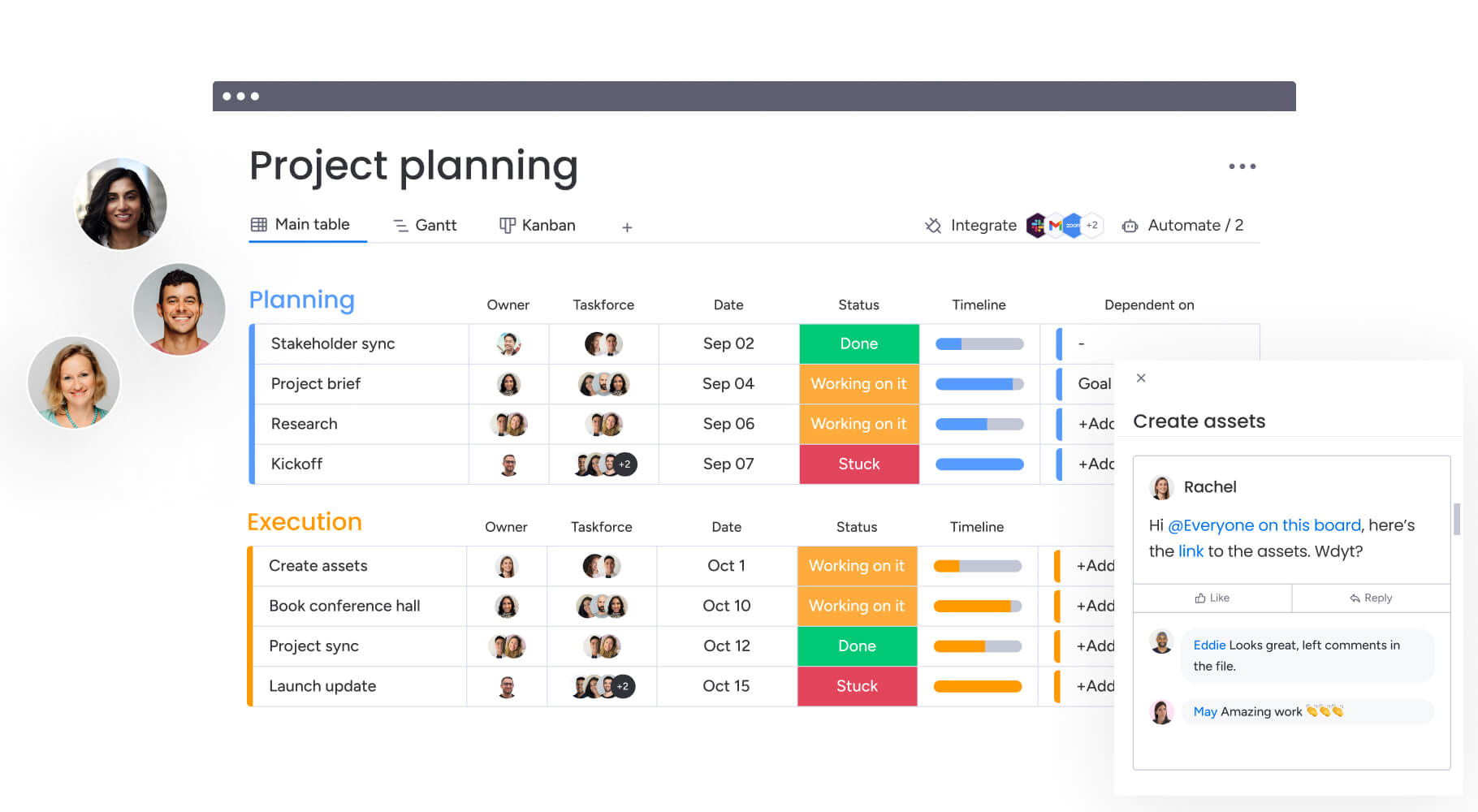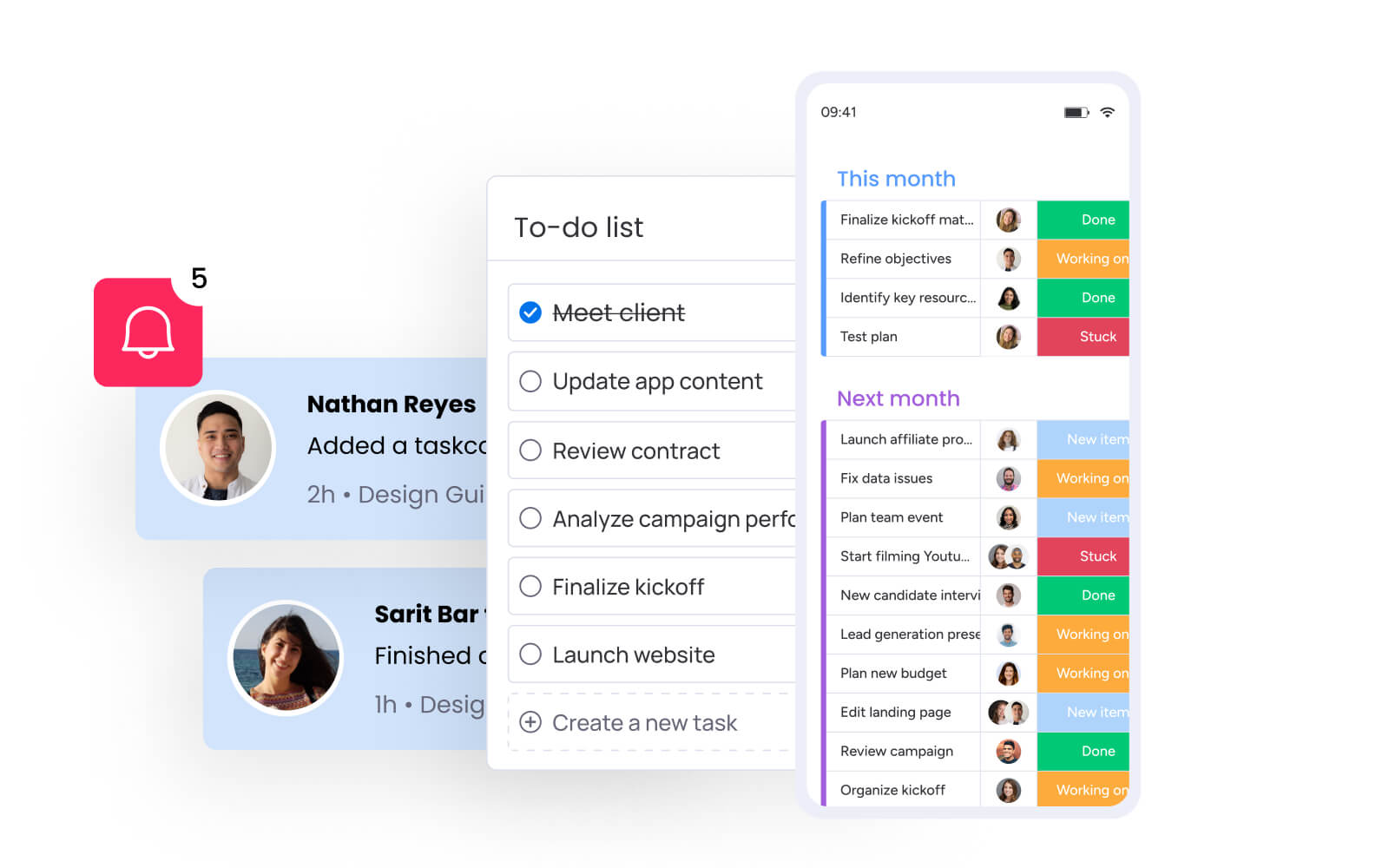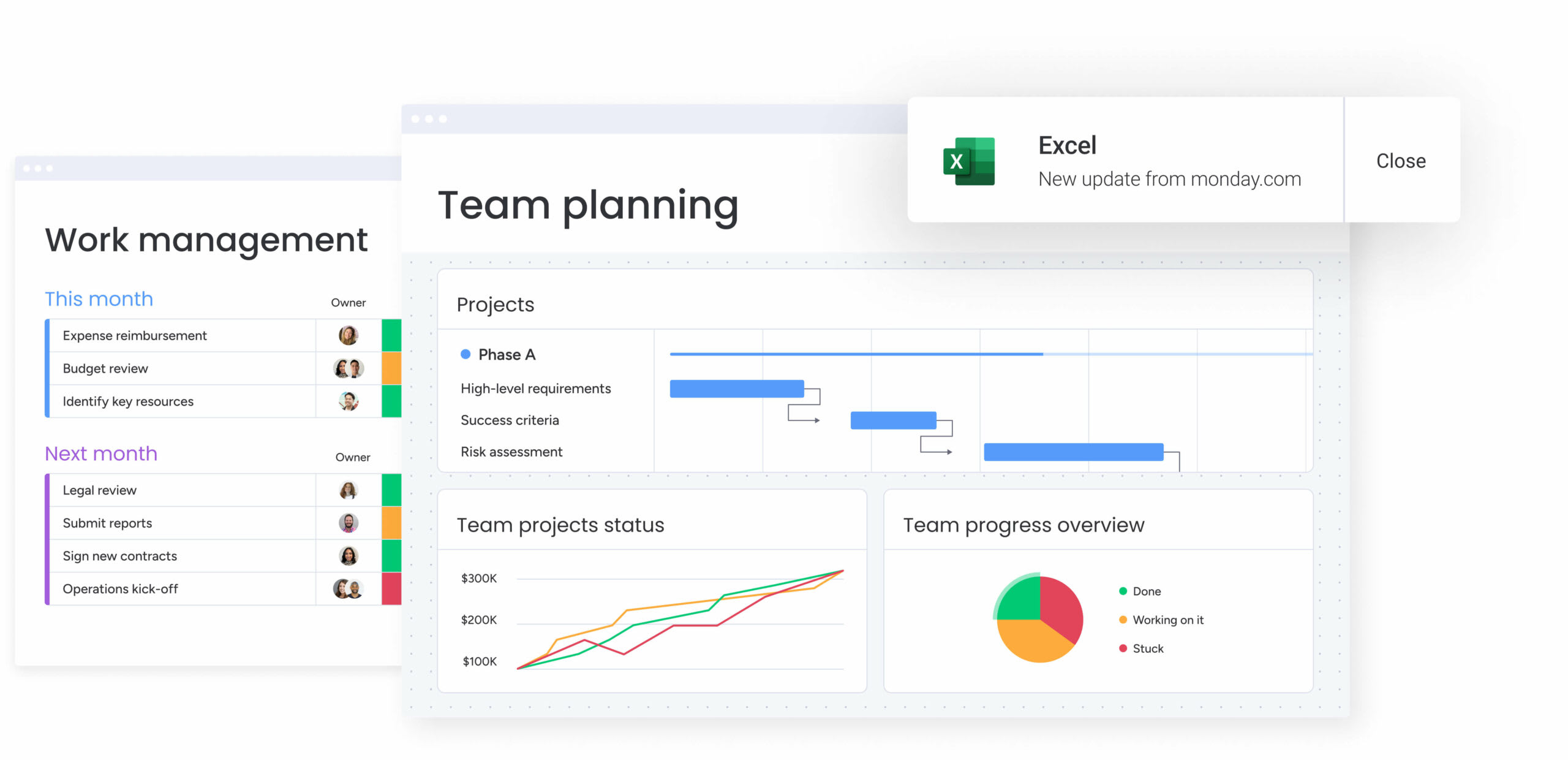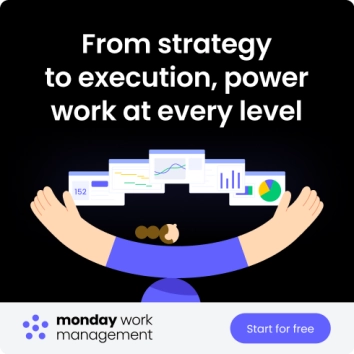Strong project collaboration brings together different skills and perspectives to move work from early concept to final delivery. When teams coordinate well, progress feels natural, information flows easily, and decisions happen quickly.
But when collaboration breaks down, even simple projects can slow down, become confusing, or stall altogether.
This helpful article explores what effective collaboration looks like today and the habits that help teams work together with clarity and momentum. You’ll learn how to spot early warning signs, create shared visibility across teams, and use practical strategies that reduce silos and keep projects moving.
You’ll also discover how a flexible digital workspace like monday work management supports these collaboration practices and brings planning, communication, and tracking into one place.
Key takeaways
-
Build shared clarity: align teams around a single source of truth to reduce confusion and rework.
-
Strengthen ownership: define clear responsibilities so every task has a dedicated decision maker.
-
Improve communication flow: use consistent channels so updates and decisions stay easy to find.
-
Use data to guide actions: track progress and identify issues early with real time insights.
-
Support collaboration on monday work management: centralize project planning and communication to keep teams aligned from start to finish.
What is project collaboration?
Project collaboration is the process of working together toward a shared goal by combining different skills, perspectives, and responsibilities. It goes beyond dividing tasks and becomes the foundation of collaborative project management, where planning, communication, and execution all happen in a shared, transparent environment.
Effective project collaboration creates conditions where information is easy to access, decisions move quickly, and everyone understands how their work contributes to the final outcome.
At its core, project collaboration means:
-
Sharing knowledge: bringing together expertise from different roles and departments.
-
Coordinating responsibilities: understanding how each piece of work connects to the bigger picture.
-
Communicating openly: keeping updates, questions, and decisions visible to everyone involved.
-
Working toward a shared outcome: aligning on priorities so the team moves in the same direction.
When teams collaborate well, organizations benefit from stronger ideas, fewer blockers, and smoother execution. It also reduces costs and duplication by making information easier to find and keeping everyone aligned.
Ultimately, project collaboration is about creating a shared space — physical or digital— where people contribute their best work and move projects forward together.

Project collaboration vs project management explained
Project collaboration and project management often work hand in hand, but they support a project in different ways. Understanding how each one contributes makes it easier to create a workflow that feels organized and collaborative at the same time.
Project management provides the structure behind the work. It focuses on:
-
Planning and scheduling.
-
Defining timelines and milestones.
-
Coordinating resources.
-
Tracking progress and overall delivery.
This gives teams a clear roadmap for what needs to happen and when.
Project collaboration brings the people side of the project to life. It encourages teams to:
-
Communicate openly.
-
Share ideas and context.
-
Work together to solve problems.
-
Stay aligned as priorities change.
This creates the environment where real teamwork can happen.
Both elements are important. Project management keeps the work organized, while collaboration keeps everyone connected, engaged, and moving in the same direction. High-performing teams rely on both to deliver consistent, high-quality results.
How to spot failing project collaboration early
Even well-aligned teams experience collaboration challenges from time to time. Small issues can grow quickly if they go unnoticed, so it helps to understand the early signs that your project collaboration process may be slipping. These are the most common indicators to watch for.
1. Information silos
Important details stay locked within certain teams or individuals. When people cannot see the full context, they make slower decisions and may unintentionally move work in different directions. It’s absolutely critical to breakdown silos.
2. Redundant work
Multiple team members complete the same tasks without realizing it. This often happens when responsibilities are unclear or when there is no shared space that shows who is doing what.
3. Missed deadlines
Bottlenecks appear because dependencies are unclear or progress is not visible. Without a real-time view of how work is moving, deadlines become harder to predict and easier to miss.
4. Meetings with little follow-through
Teams spend a lot of time discussing work, but action items are unclear afterward. Notes get lost, decisions are not recorded, and the same conversations repeat without meaningful progress.
5. Unclear ownership
Tasks are assigned to groups rather than individuals, which makes it difficult to know who is responsible for moving the work forward. Accountability slips, and important steps get overlooked.
6. Low morale
When collaboration feels disorganized or inefficient, frustration builds. Team members lose confidence in the process, which affects motivation and overall performance.
Recognizing these signs early allows teams to make adjustments before the issues become major blockers. Clear ownership, consistent communication, and shared visibility help restore momentum and strengthen collaboration across the project.

Steps to build more effective project collaboration
Improving project collaboration requires more than good intentions. Teams need clear processes, shared visibility, and tools that make communication and coordination feel effortless. The strategies below highlight practical steps any team can take to strengthen alignment and keep projects moving forward.
1. Establish a single source of truth
When information is spread across multiple tools, teams lose time searching for the latest updates. Turn to a centralised workspace by utilising platforms like monday work management: brings tasks, files, timelines, and decisions together in one place.
This helps everyone stay aligned on priorities and reduces confusion across teams.
2. Define clear roles and responsibilities
Ambiguity slows projects down. Each task should have a specific owner who is responsible for moving it forward. Clear ownership improves accountability and helps team members understand how their work fits into the bigger picture.
3. Standardize communication channels
Scattered conversations make it difficult to track decisions or revisit context. Choose consistent places for project communication, such as dedicated channels for real-time messages and structured spaces for task-specific updates. Consolidated communication keeps information easy to find and follow.
4. Automate repetitive workflows
Manual updates take time and often lead to errors. Automations can handle routine actions like sending reminders, updating task statuses, or assigning owners when work moves forward. This frees teams to focus on more meaningful tasks and reduces the risk of missed steps.
5. Foster cross-functional visibility
Projects move faster when teams understand how their work affects others. High-level views of timelines, workloads, and dependencies help identify potential blockers early. Visibility also encourages better collaboration by showing how work flows across teams.
6. Leverage data for better decisions
Real-time insights help teams understand progress, spot risks, and adjust plans proactively. Dashboards, reports, and tracking tools allow teams to monitor timelines, workloads, and key metrics without relying on manual updates.
7. Create a culture of feedback
Healthy collaboration depends on open communication. Encourage team members to share ideas, ask questions, and offer constructive feedback throughout the project. A continuous feedback loop helps improve processes and strengthens trust within the team.
Project collaboration strategies for remote and hybrid teams
Remote and hybrid teams rely heavily on clear communication and shared visibility, which makes project collaboration even more important. Without the benefit of working in the same space, teams need reliable ways to stay aligned, understand priorities, and keep work moving across time zones.
Successful collaboration in these environments depends on a few key elements:
-
A shared digital workspace that lets everyone see tasks, ownership, progress, and upcoming deadlines.
-
Consistent communication habits so updates and decisions do not get lost across different channels.
-
Flexible ways to contribute, whether team members work synchronously or asynchronously.
A platform like monday work management supports these needs by bringing planning, communication, and documentation together. Remote teams can brainstorm and collaborate in docs, leave updates directly on items, and use dashboards to understand progress without waiting for a meeting.
How to overcome common project collaboration problems
Even with clear goals and the right skills in place, teams can still struggle to collaborate effectively. Many of these issues stem from gaps in communication, visibility, or ownership. Understanding the most common challenges makes it easier to address them before they affect project outcomes.
Misaligned goals across teams
Different departments often prioritize their own deliverables, which leads to unclear expectations and competing timelines. Alignment improves when teams share the same project objectives and understand how their work supports the overall outcome.
Scattered tools and disconnected workflows
When work lives across emails, spreadsheets, chats, and documents, collaboration becomes harder. Information gets missed, updates are inconsistent, and teams lose time switching between tools. A shared digital workspace reduces this complexity and keeps everyone working from the same source of truth.
Limited visibility into progress
Without a clear view of who is doing what, it becomes difficult to anticipate delays or understand how tasks connect. Teams need accessible, real-time visibility into ownership, deadlines, and dependencies to stay coordinated.
Inconsistent communication habits
Some team members rely on chat, others prefer email, and others update documents instead. When communication happens everywhere, it becomes difficult to track decisions or find the information needed to move work forward. Agreed-upon communication norms keep conversations organized and easier to follow.
Difficulty collaborating across time zones
Distributed teams often struggle with delayed feedback, slow decision making, and unclear handoffs. Asynchronous-friendly tools and structured update habits make it easier for teams to contribute on their own schedules without slowing the project down.
Remember, effective decision making is key, as highlighted in this guide by McKinsey.
Unclear roles and decision paths
When responsibilities are not well defined, work stalls because no one knows who should make the final call. Projects move faster when each task has a clear owner and teams understand how decisions should be made.

Power your collaboration with monday work management
Effective project collaboration relies on shared visibility, clear ownership, and a workspace that keeps everyone aligned. A flexible platform like monday work management brings these elements together so teams can plan, track, and manage project execution in one place.
Teams can organize every stage of a project using customizable boards that show tasks, owners, timelines, and dependencies. Visual Views help teams understand progress and workload at a glance, including:
-
Timeline View: for scheduling and long-term planning
-
Gantt View: for mapping dependencies and delivery paths
-
Workload View: for balancing team capacity
-
Dashboards: for real time insights across multiple projects
Automation features reduce manual work by handling routine actions such as sending reminders, assigning owners, or updating statuses. Integrations with Slack, Microsoft Teams, Google Drive, and Jira keep communication and files connected to the work itself instead of scattered across tools.
AI capabilities support teams by summarizing updates, structuring information, and helping keep documentation clear and consistent. Collaborative Docs make it easy to brainstorm, co-edit, and keep discussions tied to the work they support.
Together, these capabilities create a shared digital workspace that helps teams stay aligned, reduce friction, and collaborate more effectively from anywhere.
Frequently asked questions
FAQs
What are the key elements of successful project collaboration?
Successful project collaboration is built on several key elements: clear goals that everyone understands, open and standardized communication channels, well-defined roles and responsibilities, a centralized platform or single source of truth for all project information, and a culture of trust and mutual respect where feedback is encouraged.
What is an example of project collaboration?
A great example is a marketing team launching a new product. The content writer, graphic designer, social media manager, and project manager all work together on a shared monday.com board. The board tracks every task from drafting copy to finalizing designs and scheduling posts. Everyone can see real-time progress, share files, and provide feedback directly on tasks, ensuring the campaign launches smoothly and on time.
How do you improve collaboration in a remote team?
To improve remote collaboration, you should use a centralized Work OS like monday.com to act as a single source of truth. It's also vital to standardize communication tools to keep conversations organized, set clear expectations for asynchronous work, and use visual project tracking tools like Gantt charts and Kanban boards to maintain visibility for all team members, regardless of their location.
What are the best tools for online project collaboration?
The best tools for online project collaboration are comprehensive platforms that do more than just manage tasks. While point solutions exist for specific needs, a Work OS like monday.com offers the most value by combining task management, communication, file sharing, reporting, and automation in one place. Its flexibility allows teams to build custom workflows, and its integrations connect with other essential tools, creating a truly unified digital workspace.
- Tags:
- Project team management

